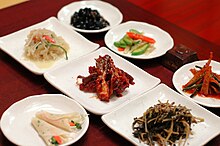Banchan
| Banchan | |
 Various banchan served at a table | |
| Korean name | |
|---|---|
| Hangul | 반찬 |
| Hanja | |
| Revised Romanization | banchan |
| McCune–Reischauer | panch'an |
Banchan (also spelled panch'an) refers to small dishes of food served along with cooked rice in Korean cuisine. This word is used both in the singular and plural. The most famous banchan is kimchi.
Banchan are set in the middle of the table to be shared. At the center of the table is the secondary main course, such as galbi or bulgogi, and sometimes a shared pot of stew. While the main course of the meal is sticky rice. Bowls of cooked rice and soup are set individually. Banchan are served in small portions, meant to be finished at each meal. They can be replenished during the meal as they are finished. Usually, more formal meals have more banchan. The Jeolla province is famous for serving many more kinds of banchan in a single meal.
Different kinds of banchan
Kimchi
Kimchi is fermented vegetables, usually baechu (Napa cabbage), seasoned with chili peppers and salt. This is the essential banchan of a standard Korean meal. Some Koreans do not consider a meal complete without kimchi. Kimchi can be made with other vegetables as well, including spring onions, Brassica juncea (gat, 갓), and radishes (mu, 무).
| Name | Korean name | Description |
|---|---|---|
| Nabak kimchi | 나박김치 | firmer and less spicy baechu and mu floating in pink watery brine |
| Dongchimi | 동치미 | various vegetables in white brine. Nabak kimchi and dongchimi are referred to as mul kimchi (물김치), literally "water kimchi." |
| Geotjeori | 겉절이 | freshly made kimchi to be eaten crisp without fermenting. Often made with baechu. |
| Ggakdugi | 깍두기 | mu cut into cubes and seasoned with red chili peppers |
| Oi sobagi | 오이 소박이 | cucumbers stuffed with chili and spring onions |
| Chonggak kimchi | 총각김치 | whole mu with chili pepper seasoning. It is made with dallangmu, about the same size as sausages. |
| Yeolmu kimchi | 열무김치 | thin and small young summer radish kimchi, which can be prepared either with or without fermented fish sauce. |
| Pa kimchi | 파김치 | hot and salty scallion kimchi, seasoned with lots of myeolchijeot, the Korean version of salted anchovies. |
| Gat kimchi | 갓김치 | Indian mustard leaf kimchi with a large amount of red pepper powder and the unique bitter taste and aroma. Strong myeolchijeot and glutinous rice paste can reduce hot and bitter taste.[1] |
Namul
Namul (나물) refers to steamed, marinated, or stir-fried vegetables usually seasoned with sesame oil, salt, vinegar, minced garlic, chopped green onions, dried chili peppers, and soy sauce.
| Name | Korean name | Description |
|---|---|---|
| Kongnamul | 콩나물 | Cold boiled bean sprouts with sesame oil. |
| Sigeumchi namul | 시금치나물 | Lightly parboiled spinach dressed with sesame oil, garlic, and soy sauce. |
| Miyeok muchim | 미역무침 | Miyeok (wakame, a seaweed) with sweet vinegar and salt. |
| Musaengchae/Muchae | 무생채/무채 | "Noodles" of white radish in a sweet vinegar sauce, sometimes with ground dried chili peppers. |
| Gosari namul | 고사리나물 | Prepared fern shoots that have been stir-fried. |
| Chwinamul | 취나물 | Stir-fried and seasoned Aster scaber. |
| Bireum namul | 비름나물 | Parboiled and seasoned amaranthus. |
| Naengi namul | 냉이나물 | Parboiled and seasoned shepherd's purse. |
| Dollamul | 돌나물 | Raw Sedum with pepper sauce dressing. |
| Gogumasun namul | 고구마순나물 | Boiled/seasoned sweet potato shoots. |
| Gaji namul | 가지나물 | Boiled eggplant. |
| Doraji namul | 도라지나물 | Boiled Chinese bellflower roots. |
Bokkeum

Bokkeum (볶음) is a dish stir-fried with a sauce
- Ojingeochae bokkeum (오징어채볶음) — made by stir-frying dried shredded squid seasoned with a mixture of gochujang (chili pepper paste), garlics, and mulyeot (syrup-like condiment).[2] It is eaten as anju (food to eat while drinking), and as banchan.
- Jeyook bokkeum (제육볶음) - stir-fried pork with gochujang (chili pepper paste) sauce and onions.
- Kimchi bokkeum (김치볶음) - stir-fried kimchi, often with pork (similar to Jeyook bokkeum)
Jorim
Jorim is a dish simmered in a seasoned broth.
- Dubu-jorim (두부조림) — tofu simmered in diluted soy sauce, a little bit of sesame oil, minced garlic, and chopped green onion.
- Jang-jorim (장조림) — beef simmered in soy sauce, optionally with hard-boiled eggs or hard-boiled quail eggs
Jjim
Jjim is a steamed dish.
- Gyeran-jjim (계란찜) — eggs that have been cracked, mixed, seasoned, and steamed in a container, eaten with a spoon
Jeon

Jeon denotes a variety of pan-fried dishes. Buchimgae is a near synonym. In Japan, buchimgae is called chijimi (チヂミ), after the Gyeongsang dialect word for buchimgae, jijimi.
- Pajeon (파전) — thin pancakes with green onion. Can also be made with just eggs and green onions.
- Kimchijeon (김치전) — thin pancakes with old (ripe) Kimchi.
- Gamjajeon (감자전) — Korean-style potato pancakes
- Saengseon jeon (생선전) — small portions of fish coated with eggs and pan-fried
- Donggeurang ttaeng (동그랑땡) — patty made with tofu and meat and vegetables, coated with eggs and pan-fried
Others
- Japchae (잡채) — A stand-alone dish in its own right, japchae can also be eaten as banchan. Japchae is translucent starch noodles accompanied with a variety of vegetable and beef in a slightly-sweet garlic sauce.
- Korean-style potato salad (감자 샐러드) with apples and carrots
See also
- Korean cuisine
- Finger food
- Okazu
- Meze, a selection of small dishes in the Eastern Mediterranean
- Tapas, a wide variety of appetizers in Spanish cuisine
